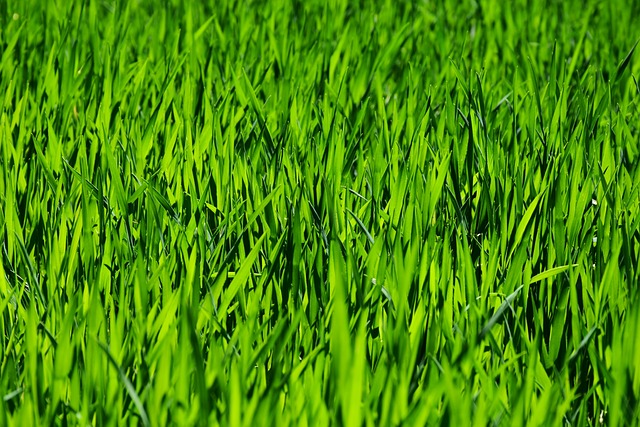Effective lawn care and landscaping are key to maintaining a healthy, aesthetically pleasing, and environmentally friendly lawn. Optimal grass height—two to four inches for cool-season varieties and taller for warm-season types—should be maintained through regular mowing at higher settings to encourage deeper root growth. The type of mower used impacts grass health; reel mowers offer a precise cut beneficial for the environment, while push mowers are user-friendly and efficient. Keeping mower blades sharp prevents damage to grass that could lead to disease and pests. Varying mowing patterns can prevent soil compaction and improve lawn resilience. These practices, combined with annual aeration, strategic fertilization, and sowing a diverse mix of grass varieties suited to local conditions, create a robust defense against weeds and pests year-round. Additionally, emulating natural precipitation patterns with watering promotes deep root growth. Managing thatch and weeds through raking or dethatching, and using mulching mowers to recycle clippings, further enhances lawn health. Landscaping features like flower beds add visual interest and complement the yard's overall appeal. By integrating these comprehensive lawn care strategies, you can achieve a resilient, lush lawn that reflects attentive maintenance and natural beauty, ensuring your landscape stands out.
Embark on a journey through the essentials of lawn care and landscaping with our comprehensive guide. Discover how to maintain a lush, thriving yard by mastering the art of lawn mowing and adhering to best practices in lawn maintenance. Whether you’re a novice or an experienced gardener, this article will equip you with valuable insights for a healthy, beautiful landscape. Dive into the fundamentals of lawn mowing and learn how these practices form the cornerstone of a vibrant yard, contributing to the overall aesthetic and health of your outdoor space.
- Understanding the Fundamentals of Lawn Mowing for a Vibrant Yard
- Comprehensive Guide to Lawn Maintenance and Landscaping Best Practices
Understanding the Fundamentals of Lawn Mowing for a Vibrant Yard

Engaging in regular lawn mowing and maintenance is pivotal for cultivating a lush, vibrant yard. To achieve this, it’s essential to understand the optimal height at which to cut your grass; most cool-season grasses should be kept between two and four inches tall, while warm-season varieties fare best slightly taller. Mowing frequency is also a key factor: frequent, high cuts encourage deeper root growth, leading to a more robust lawn. The type of mower you use can influence the health of your yard; reel mowers provide a cleaner cut and are environmentally friendly, while gas or electric push mowers offer versatility and efficiency. Remember to always keep your mower blades sharp to avoid tearing the grass, which can invite disease and pests. Additionally, alternating mowing patterns prevents compacted soil and promotes grass resilience, contributing to an overall healthier lawn. Lawn care and landscaping practices, when combined with meticulous mowing, create a thriving outdoor space that’s both aesthetically pleasing and environmentally sound. Regular maintenance, including proper mowing techniques, fosters a robust root system and enhances your yard’s natural defenses against weeds and pests, ensuring a lush green space all year round.
Comprehensive Guide to Lawn Maintenance and Landscaping Best Practices

Engaging in consistent lawn care and landscaping is pivotal for fostering a lush, vibrant yard. A well-maintained lawn not only enhances the aesthetic appeal of your property but also promotes soil health and biodiversity. Key practices include regular mowing at the optimal height for your grass type to encourage root growth and prevent weed intrusion. Aerating your lawn annually helps alleviate soil compaction, allowing air, water, and nutrients to penetrate the soil more effectively. Additionally, applying a balanced fertilizer according to the specific needs of your turf ensures nutrient availability throughout the growing season.
Incorporating a diverse range of grass types can create a resilient lawn that better withstands pests and diseases. Watering practices should be tailored to your local climate and soil type, focusing on deep, infrequent watering to foster deeper root systems. Regularly removing thatch and overseeed weeds through raking or dethatching aids in maintaining a clean, healthy lawn. Mulching mower settings can recycle clippings, returning valuable nutrients to the soil while reducing the need for additional fertilizer. Finally, integrating landscaping elements like beds for perennials and annuals can complement your green space, adding color and texture that enhances the overall ambiance of your outdoor environment. By adhering to these lawn care and landscaping best practices, you’ll cultivate a yard that stands out as a testament to meticulous care and natural beauty.
Lawns are more than mere patches of green; they’re a canvas for displaying the artistry of lawn care and landscaping. By adhering to the fundamental principles of lawn mowing outlined in this article, homeowners can maintain a yard that thrives with health and beauty. The comprehensive guide to lawn maintenance and landscaping best practices offered here serves as a roadmap to achieving and sustaining an enviable outdoor space. With consistent attention and care, your lawn will not only serve its purpose but also become a source of pride and pleasure, enhancing the curb appeal of your home and creating a tranquil retreat for relaxation and enjoyment. Remember, a well-maintained lawn is a testament to responsible stewardship of the environment and contributes positively to the community’s aesthetic landscape.
